|
Lancia, one
of the most famous and evocative of all the major automotive
brand names, was founded exactly 100 years ago. To
celebrate this milestone Italiaspeed is presenting an
exclusive 15 part history of Lancia.
For the first
fifteen-odd years of the company’s existence, Lancia had
manufactured cars which were good performers, practical and
lightweight, with a number of technical innovations. But in
the grand scheme of things, each was a stepping stone to the
model with which Lancia would truly make his name. Developed
and on the road in 1921, shown to the public at the Paris
Salon in 1922, in production by 1923; with the Lambda,
Lancia pulled together a great number of influential ideas
in a single car, and although none was entirely new, their
combination and execution in the Lambda immediately marked
it as a great leap forward. The biggest single innovation,
and one which instigated a revolution in car design, was the
adoption of a load-bearing body and the deletion of the
separate chassis. Another first was the use of independent
front suspension, while the ‘Tipo 67’ V4 engine, designed by
Ingegneres Rocco, Cantarini and Quarello, was also highly
advanced. An unusually short engine thanks to its layout,
the Tipo 67 employed a cast-aluminium engine block,
aluminium pistons, a 13° V-angle and overhead camshafts,
resulting in an output of 49 bhp at an unusually high 3250
rpm.
It is worth
pausing for a moment to explore the inspiration for the
Lambda’s two most important innovations. Although the
execution of a unitary chassis (where the chassis frame and
body frame were fabricated in steel to form a single unit)
was revolutionary in an automotive context, it was not
unprecedented in other areas of industrial design. Legend
has it that one day, Vincenzo Lancia found himself on board
a ship travelling to the U.S. in an unforgiving sea, and
watching the ship’s hull battling against the conditions
inspired him to develop a car with a unitary body – but this
account remains unverified.
It is however
true that the Lambda’s independent front suspension owes its
origins to Signor Lancia. As Paul Vellacott has observed,
“Lancia was well aware of the importance of minimising
unsprung weight and used pressed steel ‘U’ section front
axles, rather than heavier cast steel, on models up to the
1919 Kappa. Following an accident caused by a broken front
axle on a Kappa, Lancia realised that an independent front
suspension would remove the risk of broken axles and improve
handling by reducing unsprung weight.
“Having
identified a solution to the problem, Vincenzo Lancia did
not slave over a drawing board to refine the solution, but
handed the challenge over to his design engineers, the most
outstanding of whom was, undoubtedly, Battista Falchetto.
The story of how Falchetto, on being asked by Vincenzo
Lancia to come up with an independent front suspension
solution to remove the hazard he had experienced with the
Kappa’s broken front axle, is now part of Lancia lore.
Falchetto worked well into the early hours of the next
morning to produce sketch drawings of 14 possible
independent front suspension (IFS) designs. That his 1921
sketches included virtually every type of IFS introduced by
other car manufacturers during the next thirty years is
quite remarkable.” The sliding pillar design eventually
chosen was highly significant, for derivations of the type
would underpin the front of every new Lancia from then on,
up to the 1953 Appia.
The Lambda was
not just a modern car for its time – many of the solutions
it pioneered (such as a remote central gearchange,
integrated luggage boot and transmission tunnel) would find
themselves in use well after the Second World War. Speak to
Lambda owners today and apart from unstinting devotion to,
and praise for, their cars, there is one remark in
particular which comes through – that they drive almost like
modern cars, a world away from other cars of equivalent
vintage. With their long, low-slung appearance, they
certainly looked different: according to Penny Sparke, the
launch of the Lambda meant that, “for the first time, a car
could really be thought of and conceived from the outset, as
a single visual entity.”
The Lambda was
in planning for some time, with the original patent for a
‘frameless car’ filed on New Year’s Eve, 1918. An unproven
idea, it was put on the backburner for the next couple of
years as Lancia pursued development of his new V12, but with
these plans falling through, attention focused once again on
the design in the patent as the way forward, with the
go-ahead given in March 1921. One area of dissent in the
development of the car was over the issue of brakes, with
Lancia for a long time remaining sceptical of Falchetto’s
belief in four-wheel brakes, believing that rear brakes were
entirely adequate for the car. It was fortunate that
Falchetto managed to convince Lancia after a test run in a
car equipped only with front brakes, for as Trow notes,
“Lambda braking proved to be one of the features that deeply
impressed contemporary commentators.”
Throughout its
nine-year life, the Lambda underwent an extensive series of
evolutions. Briefly, the original specification saw a top
speed of between 70 and 75 mph, with a touring consumption
figure of around 26 mpg. These first cars were almost all
bodied in-house by Lancia, the new load-bearing body
reducing the scope for the coachbuilders, although a few did
make some attempts. The first four series saw small
improvements such as new pistons, different windscreen
designs and a change in supplier of the electrical system
(from Bosch to Marelli). The fifth series saw the adoption
of a four-speed gearbox to replace the previous
three-speeder, whilst the sixth series used a wheelbase
stretched by 320mm and was also produced as a chassis for
the coachbuilders. In 1926, the seventh series saw an
enlarged capacity engine (up to 2370cc) producing another 10
bhp, and was produced with both the longer and shorter
wheelbases, a feature also used in the following eighth
series (1928-1929). The latter also received an even larger
and more powerful engine (2570cc) with a further 10 bhp, now
achieved at 3500 rpm, to offset the ever-increasing
weight. By 1931 and the series 9, the Lambda had racked up
production of nearly 13,000 units, easily making it Lancia’s
best-selling model thus far. Throughout this period, the
company itself would also undergo a considerable shakeup,
with Fogolin resigning in 1921 and the rest of the firm’s
founding members (Rocco, Cantarini and Zeppegno) all
departing some time afterwards.
Thanks to their
outstanding handling and braking performance, Lambdas were
also a natural choice for competition purposes. They were
successfully utilised extensively in motorsport in various
guises, mostly by private entries, albeit supported by the
factory. Officially, the factory was uninterested in motor
racing, but Vincenzo Lancia never truly lost the racing bug
from his youth, and a 2.5-litre model was prepared by the
factory for the 1928 Mille Miglia. Despite lacking
performance on paper compared with the supercharged
1.5-litre Alfa Romeo Super Sport of Campari and Ramponi,
Gismondi was able to keep in touch as a result of the
Lambda’s superior handling, only retiring from second place
in the final leg when the engine dropped a valve.
The 1930s and
new challenges
A couple of
years prior to the Lambda ceasing production, in 1929, the
rather more conventional Dilambda had been introduced to the
market. Despite its name, this was not a replacement for the
Lambda, but a far bigger model, aimed at a different type of
customer – Lancia’s first true luxury car. In fact, it was
born as a project for the U.S. market and displayed at the
New York Motor Show as early as 1927, complete with plans to
manufacture there, but when the venture collapsed (with no
less than a serious threat on Vincenzo’s life), the car was
modified for the European market and eventually went into
production in 1929. Although it included innovative
features, such as a structural fuel tank, independent front
suspension similar in design to the Lambda, and was one of
the first cars to be fitted with a hypoid bevel, the
Dilambda returned to a separate chassis construction to
satisfy the demands of the coachbuilding industry, who would
be integral to providing a choice of bodies, as would be
expected by the buyer of such a car. Typically, customers
had a choice between a four-door, four-seat saloon, a
two-door ‘coupe de ville’, and a two-door cabriolet. Amongst
others, the Dilambda is notable for providing the base for
the first official Pinin Farina special. Lancia and Farina
were good friends and the former was crucial to persuading
Farina to branch out on his own by providing commissions.
The Dilambda was
a large car, the finished vehicle rarely weighing less than
two tonnes, and was built in correspondingly small numbers.
The total production was just under 1700 cars, with the
majority built between 1929 and 1932, although it remained
available to special order for a few more years
afterwards. It was propelled quite adequately for its
purpose by a superb new 100 bhp 4-litre V8 engine, developed
from the Trikappa’s motor but in actuality a quite different
engine, with a V-angle of 24°, pushrod-operated valves (the
first Lancia V engine with this valvegear arrangement) and
one-piece casting of the iron cylinder block.
The extent of
the Lambda’s advancement had made it the car of choice for
the discerning motorists of Europe – a point emphasised by
the fact that Lancia sold cars via reputation rather than
advertising. Moreover, according to Automotive News,
“Lancia (had) gained economies of scale by using the most
sophisticated tooling available. The result was that his
company could produce more than 4,000 units of his high-end
models a year by the 1930s”, while continued investment in
manufacturing methods allowed low-volume production of
improved models, such as the Astura and Artena, which would
debut in 1931 and herald a new era for the company.
With the
Dilambda meeting the demand for a large vehicle, Lancia went
about developing a replacement for the Lambda, to be
available both as a base model and a more luxurious model,
sharing their basic layout. The result was, respectively,
the Artena and the Astura. The resulting common chassis drew
heavily on the design of the preceding Lambda and Dilambda,
albeit with a sensible dose of cost-saving measures, with
the front and rear suspension also following the same basic
layout as those models.
For the Artena
it was decided to retain the well-tried narrow-angle V4
layout, but while it has been described as a much-developed
version of the Lambda’s V4 with numerous major modifications
(such as the adoption of a chain drive for the camshaft),
the changes were so extensive it could just about be called
an all-new engine. Whilst an overhead camshaft layout
remained, an iron block was substituted in favour of the
Lambda’s alloy specification, with the V-angle set at
17°. Slightly under two litres in capacity, a significant
innovation was its mounting via silentblocks, which
drastically reduced the vibrations passed into the
chassis. The Astura, on the other hand, got a simplified and
reduced-capacity version of the existing V8. Measuring 2.6
litres in capacity and developing 73 bhp at 4000 rpm, the
new V8 was essentially quite similar in concept to the
Artena’s V4; clearly with eight cylinders and with a
slightly expanded V-angle (19°), but much the same in basic
design and layout.
The Astura,
writes Wim Oude Weernink, was, “not a Lancia technical
tour de force with regard to chassis design,
(but)...must nevertheless be considered as one of the best
pre-war Lancias from the points of view of quality,
durability and practicality.” Even if they did not display
the innovation of the Lambda, the Astura and Artena were
fine-handling cars in the by-now Lancia tradition, with
their compact engines sited low-down in the chassis, precise
steering and well-developed front suspension allowing them
to realise Lancia’s mantra that they should be able to
maintain, “a high average speed under average conditions”.
|
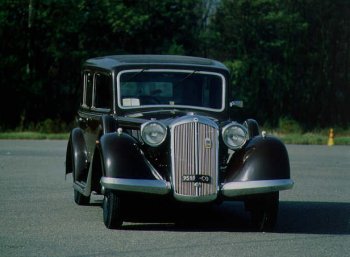
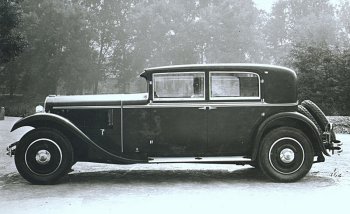 |
|
The Dilambda
was a large car, the finished vehicle rarely
weighing less than two tonnes, and was built in
correspondingly small numbers. The total production
was just under 1700 cars, with the majority built
between 1929 and 1932. |
|
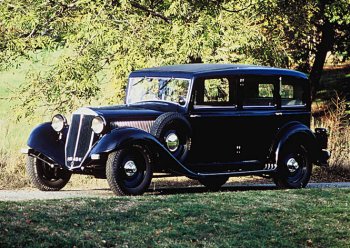
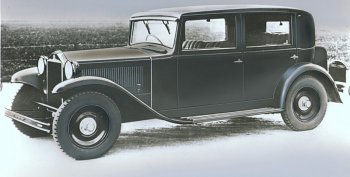 |
|
For the Artena
it was decided to retain the well-tried narrow-angle
V4 layout, but while it has been described as a
much-developed version of the Lambda’s V4 with
numerous major modifications (such as the adoption
of a chain drive for the camshaft), the changes were
so extensive it could just about be called an
all-new engine. |
|
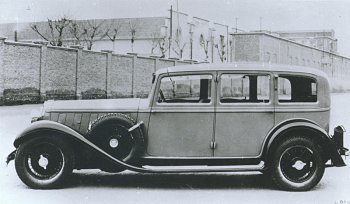 |
|
The Astura,
writes Wim Oude Weernink, was, “not a Lancia technical 'tour de force' with regard to chassis design,
(but)...must nevertheless be considered as one of the best
pre-war Lancias from the points of view of quality,
durability and practicality.” |
|
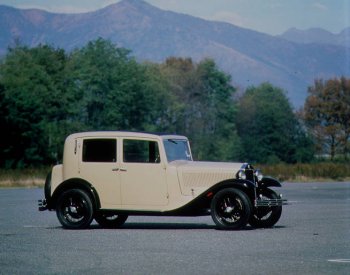
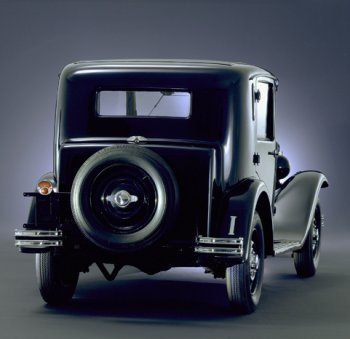 |
|
The first ‘compact’ Lancia designed to be produced
in large volumes, the Augusta was first shown to the
public in 1932, with production beginning in 1933
and a chassis version also produced for the
coachbuilders from 1934 onwards. |
|
|
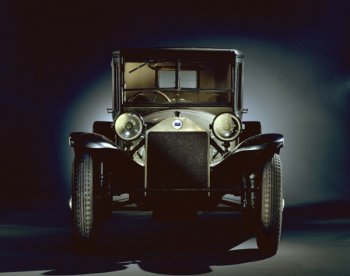
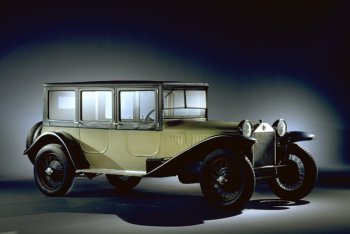
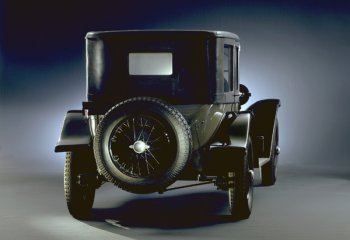 |
|
Developed and on the road in 1921, shown to the
public at the Paris Salon in 1922, in production by
1923; with the Lambda, Lancia pulled together a
great number of influential ideas in a single car,
and although none was entirely new, their
combination and execution in the Lambda immediately
marked it as a great leap forward. |
|
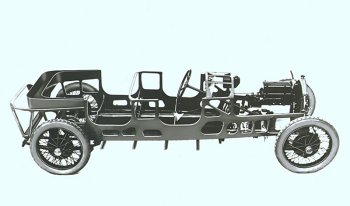 |
|
The biggest single innovation of the Lambda, and one
which instigated a revolution in car design, was the
adoption of a load-bearing body and the deletion of
the separate chassis. |
|
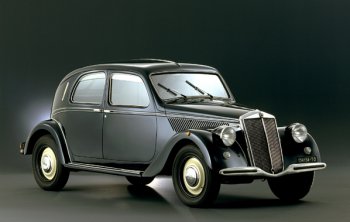
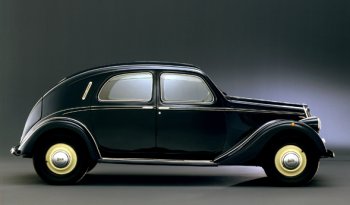 |
|
Tragically, Vincenzo Lancia would not live to see
the Aprilia go into production and receive the
plaudits it richly deserved. It was, perhaps, the
strain of running what had become a large
organisation which was taking its toll. |
|
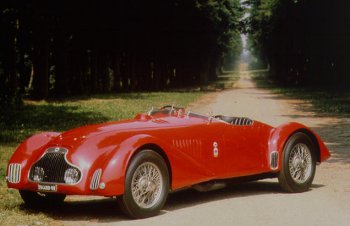
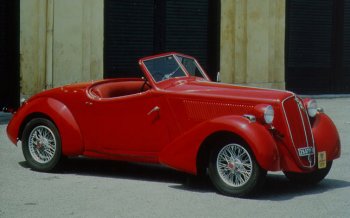 |
|
Despite its diminutive size, the Augusta was a particular favourite with
racing drivers of the era, with Tazio Nuvolari, Luigi
Fagioli, Antonio Brivio, Achille Varzi and Rene Dreyfus all
espousing the qualities of the ‘littlest Lancia’. |
|
|
In particular, early Asturas were regarded as
very sporting cars, especially when fitted with low, wide
custom bodies by the likes of Pinin Farina, Touring, Viotti
and Castagna. It was potential realised to an extent in
competition, with Pinaduca and Nardelli claiming victory in
the 1934 Circuit of Italy, a grueling trial of some 5654km
over which their Astura averaged 85km/h. Trow notes, “it
(was) to the Lancia’s credit that Pintaduca and Nardelli
beat the new 6C 2300 Alfa Romeo of Scuderia Ferrari, the
Alfa works team, by over three minutes,” while third place
was claimed by another Astura, piloted by another who would
go on to greater things – Giuseppe Farina.
However, towards
the end of its life, the Astura would increasingly evolve
into a large tourer, in much the same way as the Lambda had
done, to suit the demands of the political climate in Italy
at the time. Whilst the Artena became more utilitarian given
the poor economic conditions at the time and the limited
purchasing power of most Italians, the Astura took over as
the top-of-the-range Lancia and became more luxurious after
the cessation of production of the Dilambda in 1938. In 1934
its engine was bored out to 3 litres, raising output to 82
bhp, while a variety of different wheelbases were offered
from the third series onwards. The Astura became a favourite
of the coachbuilders and many different versions were built
by almost all of the leading names. Around 5500 Artenas and
2900 Asturas were built in production runs which lasted
throughout the 1930s.
Nevertheless,
despite the relative success of these models, the poor
economic situation in Italy was a persistent worry and the
idea of a Lancia to tempt upwardly mobile Fiat drivers,
pitched between the Fiat Ballila and the Isotta, had been
playing on the mind of Vincenzo for quite a while. In 1930,
development had begun on the new model 231, the ‘Augusta’.
The first
‘compact’ Lancia designed to be produced in large volumes,
the Augusta was first shown to the public in 1932, with
production beginning in 1933 and a chassis version also
produced for the coachbuilders from 1934 onwards. For all
that, however, it was not a car for your average Italian,
and sold only a fraction of the amount of Ballilas in a
production run lasting between 1933 and 1937. If nothing
else, the quality of the car’s construction put it in a
different league – Trow describes how it came to be thought
of my many motorists as a ‘little Rolls-Royce’.
The
small-capacity engine, meanwhile, was a marvel of sorts in
itself. Under the direction of Gianni Sola, a brand-new,
1196cc, overhead-cam 18° V4 – with an unusual weight-saving
crankcase design – was developed, producing 35 bhp at 4000
rpm. It also possessed, says Paul Vellacott, “(a)
preciseness and delicacy (to) its controls, (especially) the
steering”; this was combined with sliding pillar independent
front suspension (providing excellent handling) and Lockheed
hydraulic brakes, although this latter innovation was fitted
only after much urging from Falchetto, and was not approved
without a great deal of reluctance from Lancia following
some problems in testing.
Despite its
diminutive size, this car was a particular favourite with
racing drivers of the era, with Tazio Nuvolari, Luigi
Fagioli, Antonio Brivio, Achille Varzi and Rene Dreyfus all
espousing the qualities of the ‘littlest Lancia’. With some
specialists also carrying out supercharger conversions, the
Augusta also met with considerable motorsport success in
private hands, from the Mille Miglia to the RAC Rally, with
their most notable success a 1-2-3-4 class finish in the
1936 Targa Florio.
Altogether, the
Augusta is perhaps best summed up by L.J.K. Setright, who
wrote that it represented, “perhaps the first really
successful embodiment of an ideal that many manufacturers
had long sought: an elegant, attractive, efficient and
completely convincing good small car. Too often dismissed as
merely pleasant, the Augusta – as a transitional design
paving the way for the Aprilia – was truly important.” Why
was this? Most importantly from a chassis design point of
view, the Augusta marked a return to a true load-bearing
bodyshell, with even the roof an integral part of the
structure. The chassis was also notable for being ‘pillarless’,
with the B-pillars being omitted, allowing for outstanding
access. This, it might be expected, did little for chassis
rigidity, but in fact, thanks to ingenious design, body
rigidity was quite superb. Despite weighing just 818kg,
according to Setright, the Augusta’s chassis boasted a
torsional stiffness of 4520lb ft per degree – an outstanding
figure, “unrivalled by any racing car for at least another
twenty years and unmatched by many a minor hatchback (well
into the 1990s).”
With such
thoroughness exemplified throughout its design, the Augusta
proved a success, to the point that Lancia set up a
brand-new factory in Bonneuil-sur-Marne, in France. Between
1933 and 1937, around 2500 Augustas, renamed ‘Belna’, were
produced at this factory, while a further 600 chassis were
destined for French coachbuilders such as Franay, Figoni and
Saoutcick. Including Italian manufacture, approximately
20,000 saloons and chassis were produced in total.
By 1934,
although the Augusta, Artena, Astura and Dilambda were all
rolling off the production lines at a steady rate, Lancia’s
thoughts were already turning to his next step, “a quality
car built on mass-production lines.” The car which
resulted, the Aprilia, would continue to forge the company’s
reputation for innovation, and carve out a wonderful
reputation for its quality, spaciousness, performance and
dynamic ability.
As with the
Lambda, so with the Aprilia: way ahead of their time is an
apt description for both. Like its predecessor, it boasted
unitary construction and an overhead-cam alloy-block V4, but
it differed in the nature of its advancement. As Paul
Vellacott has observed, if the Lambda was, “a remarkably
intuitive leap in to the future, the Aprilia was more of a
considered step into the future of the motor car...(the
result of) the confidence of a further fifteen years design
experience.” Falchetto remained the chief designer, but
responsibility for engine design passed from Ingegnere Rocco
to Ingegneres Sola and Verga, with the whole operation
overseen by the company’s technical manager, Giuseppe Baggi. In
fact, this was more significant than it may appear, for
Lancia’s role as principal of the company meant he simply
could not devote the time to become involved in the car’s
development, and his direct involvement ran only to laying
down its specification, although he kept a constant eye on
its development throughout the process. This was to include
a medium-capacity engine producing around 50 bhp; space to
carry five passengers; a weight, when laden, of no more than
900kg; good aerodynamic qualities; excellent roadholding;
and possibly, if the development team saw fit,
all-independent suspension.
This last
stipulation was realised, and the result was the first
Lancia to feature fully independent suspension, a feature
still unusual at the time. As with all Lancias since the
Lambda, the front suspension was again of sliding pillar
type, but the rear was an advanced and complicated trailing
arm/torsion bar arrangement at the rear, as opposed to the
inferior swing-axle designs of many of its
contemporaries. Other noteworthy features included hydraulic
brakes (inboard at the rear) and ‘pillarless’ aerodynamic
bodywork (Cd 0.47, versus an average for the time of
0.60). This was partially shaped in the windtunnel at Turin
Polytechnic by Falchetto, with the help of Pinin Farina,
making it one of the first mass-produced cars to ‘recognise’
aerodynamics, although Lancia himself insisted on a less
radical aesthetic treatment for the tail than the ideal
solution suggested by the tests. Lightness and rigidity were
also priorities, in order to fully exploit the benefits of
independent suspension, and clever construction allowed
torsional rigidity to be improved by no less than 20 percent
over the already impressive Augusta.
On the engine
side, Sola and Verga came up with another new narrow-angle
engine, this time a 1352cc 18° V4 (which would, much later,
provide the inspiration for Volkswagen’s famous ‘VR6’
engine). This was enhanced with the use of valves
positioned at 45°, duralumin conrods, and one of the first
production applications of a cross-flow head and
hemispherical combustion chambers. Furthermore, its
spaciousness was a revelation compared with equivalent cars,
whilst its performance and handling were to a standard more
commonly associated with many sportscars of the day. Lancia
himself experienced the car for the first time on a round
trip from Turin to Bologna, at the conclusion of which he
remarked, “Che macchina meravigliosa!” What a magnificent
machine! It was a deserved accolade – even today, the
Aprilia is employed as a textbook demonstration of applied
aerodynamics, intelligent packaging and excellent
performance.
Tragically,
Vincenzo would not live to see his creation go into
production and receive the plaudits it richly deserved. It
was, perhaps, the strain of running what had become a large
organisation which was taking its toll. In the early hours
of February 15, 1937, Lancia awoke in distress, but the
discomfort was minor enough for him to think nothing of it
and avoid disturbing his wife or staff. It was not until
seven o’clock in the morning that the family doctor was sent
for, who came as quick as he could, but by then, tragically,
it was too late. Thus, one of the men who had contributed so
much to the history of motoring had unexpectedly died at the
age of 55, the victim of a heart attack. His work as a
manufacturer was marked by intuition, originality,
nonconformity and courage. Equally, it is no accident that
his spiritual legacy is a car: the Aprilia. The model, which
seems to sum up the traditions of the company and the
virtues of the man, was initially received with scepticism
and a certain degree of incredulity – the design seemed too
daring, the technical aspects too innovative. It took some
time for this Lancia to become the queen of the road:
dynamic, extremely stable, with an incredibly modern style
appreciated by all. And it was the genius of Vincenzo Lancia
that foresaw it all.
It is for his
masterpieces, the Lambda and Aprilia, that Vincenzo will be
best remembered. But as Nigel Trow notes, to allow his
reputation to rest solely on the innovations displayed in
these two cars, “is to neglect the overriding character of
all Lancia cars – their quality of understated elegance. Not
elegance in the external, decorative sense but elegance as a
nicely judged solution to given problems, resulting in
engineering as art. Lancia was not concerned with novelty,
only with the pursuit of his own personal view of the motor
car, and his real brilliance lay in an ability to weld
together a number of individually exciting ideas into a
workable whole. Underpinning this genius lay a sense of
proportion which made Lancia cars the most utterly human
vehicles ever made.” Similarly, on the philosophy of Lancia
cars, one imbued by Vincenzo himself, L.J.K. Setright
observed that, “nothing is given special emphasis, just as
nothing is dismissed as unimportant; the whole thing is a
balanced design, and it is that equilibrium which – ignoring
all temptations to exaggerate any particular aspect of its
character – has always been typical of Lancia. (Considering)
the car as a whole, rather than engaging in blinkered
pursuit of some isolated idiosyncracy, is what has made
every Lancia good and no Lancia spectacular”, and this
holistic approach is reflective of the philosophy of the
company’s founder. Although the company was never quite the
same after his passing, Vincenzo’s unique approach would
continue to imbue Lancia’s products well after his death,
even though persistent financial troubles would plague the
company over the next few decades.
by Shant Fabricatorian
|
|
|
|
![]()
![]()